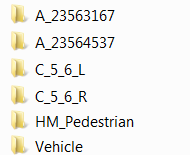Pedestrian Impact
The Pedestrian Impact tool generates a deck for the simulation of the pedestrian head impact on vehicle hoods and windshields.
- Auto Report Generation
- Interactive Section
The Pedestrian Impact tool conforms to the pedestrian safety regulations GTR, EuroNCAP and Homologation. Pedestrian Impact automates the process with minimal input from you, therefore reducing the deck generation lead time with less human error. Pedestrian Impact is available in the Crash LS-DYNA and Radioss user profiles in Engineering Solutions.
Once you have created your deck in Engineering Solutions, you can load your results into the HyperView Pedestrian Impact Browser to generate an Excel report that contains all the curves available (acceleration of the head, maximum displacement of the bonnet) for each point of the bonnet. It also contains the images of the different contours (HIC, maximum displacement, and time of maximum displacement).
From the Pedestrian Impact Browser, you can also view contours of your HIC and capture the image for later use.
- Impactor Type
- From the drop-down menu, select Head, Upper Leg, or Lower Leg.
- Solver Result
- From the drop-down menu, select Radioss or LS-DYNA for the solver type.
- Update HIC Notes
- See the HIC Target Scale definition above.
- Plotting Options
- Select any of the following options to customize your results
display:
- Use SAE filter
- Overlay WAD Lines on vehicle
- Use four window layout
- Show Displacement Contour
- Auto Report Generation
- For report generation, the Pedestrian Deck Directory, HM Output
Directory and Target Point CSV file locations are required.
- Pedestrian Deck Directory
- From the file browser, select the Pedestrian Decks Directory (the location where the pedestrian decks are solved). In this directory, there are sub-directories that contain the respective result files. All the sub-directories and result files should be named in a standard format. For example, the first two or three letters of these names should be “CL_”, “CR_”, “AL_”, “AR_”, “C_0”, “A_0” or “N_”. The image below shows the structure of the selected directory.
- HM Output Directory
- Use the file browser to select the HM Output directory (the location where the WAD Line component collector is exported). This is used to create the hard part distance contour and the WAD line overlay.
- Target Point CSV
- For Target Point CSV, click on the file browser to select a CSV file to import.
- Interactive Section
- See the Interactive Section for more information.
- Load Defaults
- Loads previously-saved selected options.
- Save Defaults
- Saves the options currently selected.
- Generate Report
- Generates the pedestrian impact report. The table in the Interactive Section of the Browser is populated with the Pedestrian Deck data.
- HIC Summary
- This creates a HIC map of all points without loading any animation files or creating a report. The time history files are used to calculate HIC and show a map of HIC points on the hood quickly. A CSV file is written with the name HicSummary.csv. You can continue to create the report by clicking the Generate Report option. When the same default file loads the next time and if a HicSummary.csv file exists in the folder, then you will be prompted with an option to use the values without processing the data again.
